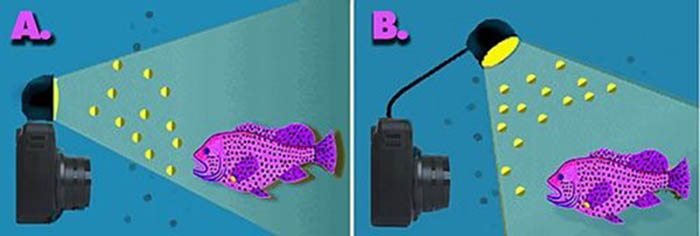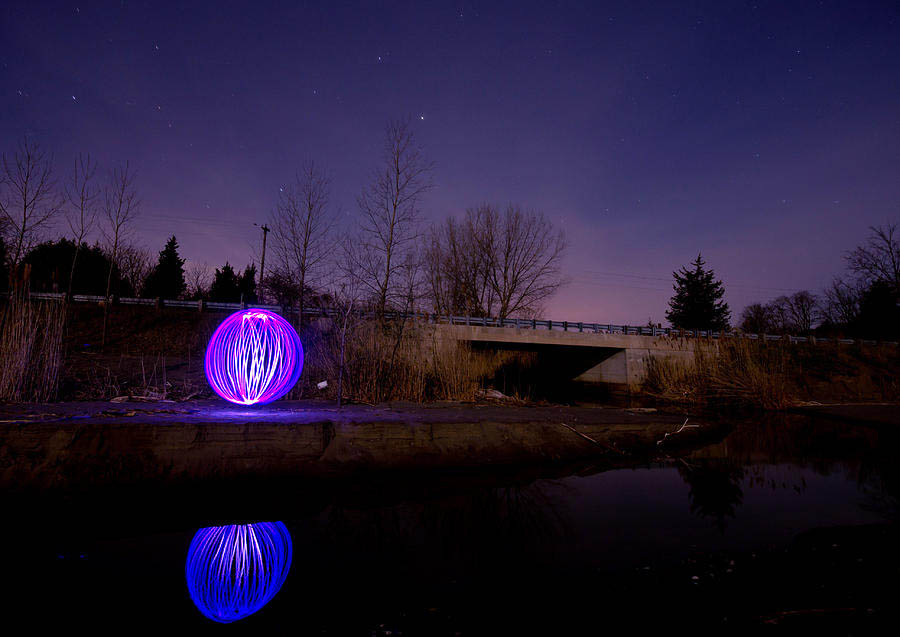Orb artifacts are captured during low-light instances where the camera’s flash is used, such as at night or underwater—or where a bright light source is near the camera. The artifacts are especially common with compact or ultra-compact cameras, where the short distance between the lens and the built-in flash decreases the angle of light reflection to the lens, directly illuminating the aspect of the particles facing the lens and increasing the camera’s ability to capture the light reflected off normally sub-visible particles.
The orb artifact can result from retro-reflection of light off solid particles (e.g., dust, pollen), liquid particles (water droplets, especially rain) or other foreign material within the camera lens.
The image artifacts usually appear as either white or semi-transparent circles, though may also occur with whole or partial color spectrums, purple fringing or other chromatic aberration. With rain droplets, an image may capture light passing through the droplet creating a small rainbow effect.

In underwater conditions, particles such as sand or small sea life close to the lens, invisible to the diver, reflect light from the flash causing the orb artifact in the image. A strobe flash, which distances the flash from the lens, eliminates the artifacts. Below are two diagrams of a hypothetical underwater instance. In Diagram A, the faces of particles directly aligned with the camera’s lens are illuminated by the flash, and thus the camera will more likely record orbs. In Diagram B, the faces of particles illuminated by the flash do not face the lens and therefore remain un-recorded.

A hypothetical underwater instance with two conditions in which orbs are (A) likely or (B) unlikely, depending on whether the aspect of particles facing the lens are directly illuminated by the flash, as shown. Elements not shown to scale.
Orbs are one of the more common paranormal phenomenon you learn about when you study ghost hunting and parapsychology. An orb is an unusual ball of light, most often found in photographs or video. But what are they, and how can you tell an authentic orb from a trick of the light?
False Orbs
There is a reason the rise of orbs caught on film has gone through the roof digital technology and the fact that everyone has a camera on them at all times has made capturing them more common. A little too common, in fact.
The fact of the matter is, most orbs caught in photos these days are not supernatural. With a little experimentation, you can replicate orbs to your heart’s content. Turn on a fan or AC in a room and take a photo with a flash; you’ll probably get at least one or two orbs, if not dozens– depending on how much dust is in the air. Minuscule moisture droplets, insects and other such debris can also show up in photos of orbs.
While most orbs can be attributed to dust and moisture catching the light or flash reflection, this is not always the case. Some orbs have distinct characteristics that are not present in dust orbs.
The same thing can happen on video; when you see an orb seemingly fall straight down, or blow across like a draft, chances are its just debris.
Most skeptics will point to these and tell you its evidence that orbs are nothing but a trick of the light caught on film, but that’s not the whole story.

Spirit Orbs
While most orbs can be attributed to dust and moisture catching the light or flash reflection, this is not always the case. Some orbs have distinct characteristics that are not present in dust orbs.
For one thing, some orbs in photos seem to be behind a thing or person, as if peeking out or passing by in the background. This is a significant difference; reflections don’t fall behind an object in the photo; a true reflection of dust will always cause an orb-like light effect in front of any person or thing in the film, because the orb is essentially a minor flair back on the lens. When the orb is behind something or someone, it’s not a reflection.
A spirit orb has more of a density to it than a natural particle orb; instead of a translucent, perfect ball, it may be misshapen, have odd shapes in it, seems thicker, more three-dimensional and less translucent.
On film, moving orbs seem to have a light of their own rather than being a reflection. They also seem to move independently—not like something caught in a breeze or wind. They may move back and forth in a room, or come in one door and go through another. This is not something dust and particles would do. An insect might, but then unless it were a firefly it would not have a glow of its own.
Orbs with the Naked Eye
Not all orbs are caught on film. There are times when orbs have been observed by people or groups of people with the naked eye. By some reports, orbs even attempt to communicate with people; they’ve deliberately come close, flown around or otherwise tried to make themselves known (or at least, this is what people who have encountered them believe the orb to be doing).
One thing you should know about spirit orbs of light is that they’re not usually associated with threatening behavior. Could these be good spirits—or at least the spirits of normal people? Could they be angels or spirit guides trying to tell us something, or hovering around us keeping their eternal watch? One day perhaps we’ll know; for now, all we can do is keep our eye on the ball.


